technical specifications FIAT STILO 2006 1.G Owners Manual
[x] Cancel search | Manufacturer: FIAT, Model Year: 2006, Model line: STILO, Model: FIAT STILO 2006 1.GPages: 274, PDF Size: 4.76 MB
Page 235 of 274
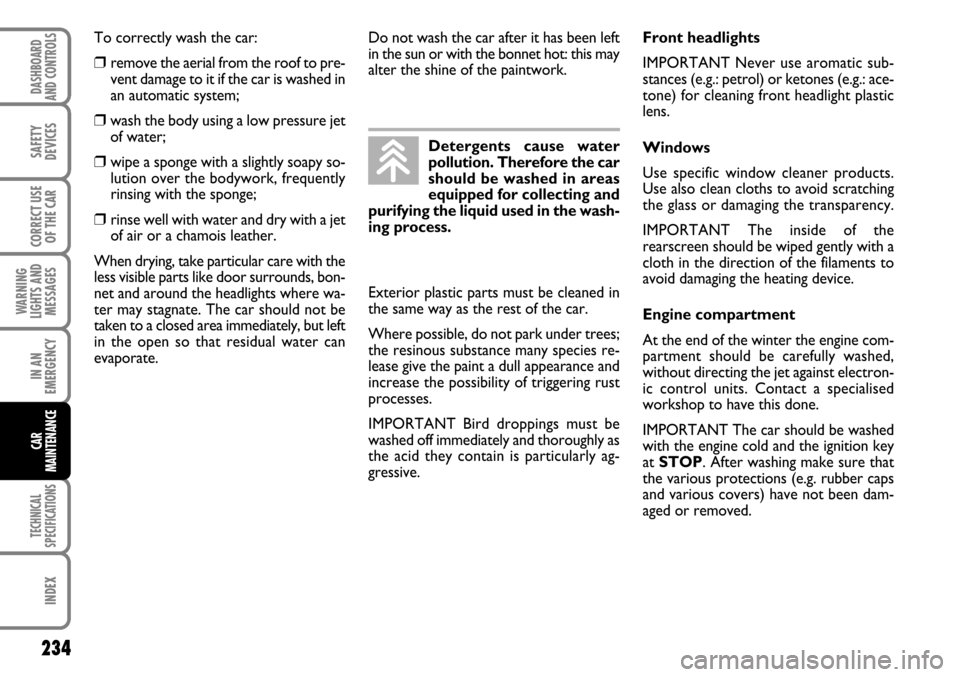
234
WARNING
LIGHTS AND
MESSAGES
TECHNICAL
SPECIFICATIONS
INDEX
DASHBOARD
AND CONTROLS
SAFETY
DEVICES
CORRECT USE
OF THE CAR
IN AN
EMERGENCY
CAR
MAINTENANCE
To correctly wash the car:
❒ remove the aerial from the roof to pre-
vent damage to it if the car is washed in
an automatic system;
❒wash the body using a low pressure jet
of water;
❒ wipe a sponge with a slightly soapy so-
lution over the bodywork, frequently
rinsing with the sponge;
❒ rinse well with water and dry with a jet
of air or a chamois leather.
When drying, take particular care with the
less visible parts like door surrounds, bon-
net and around the headlights where wa-
ter may stagnate. The car should not be
taken to a closed area immediately, but left
in the open so that residual water can
evaporate.Exterior plastic parts must be cleaned in
the same way as the rest of the car.
Where possible, do not park under trees;
the resinous substance many species re-
lease give the paint a dull appearance and
increase the possibility of triggering rust
processes.
IMPORTANT Bird droppings must be
washed off immediately and thoroughly as
the acid they contain is particularly ag-
gressive.Front headlights
IMPORTANT Never use aromatic sub-
stances (e.g.: petrol) or ketones (e.g.: ace-
tone) for cleaning front headlight plastic
lens.
Windows
Use specific window cleaner products.
Use also clean cloths to avoid scratching
the glass or damaging the transparency.
IMPORTANT The inside of the
rearscreen should be wiped gently with a
cloth in the direction of the filaments to
avoid damaging the heating device.
Engine compartment
At the end of the winter the engine com-
partment should be carefully washed,
without directing the jet against electron-
ic control units. Contact a specialised
workshop to have this done.
IMPORTANT The car should be washed
with the engine cold and the ignition key
at STOP. After washing make sure that
the various protections (e.g. rubber caps
and various covers) have not been dam-
aged or removed. Detergents cause water
pollution. Therefore the car
should be washed in areas
equipped for collecting and
purifying the liquid used in the wash-
ing process.
Do not wash the car after it has been left
in the sun or with the bonnet hot: this may
alter the shine of the paintwork.
Page 236 of 274
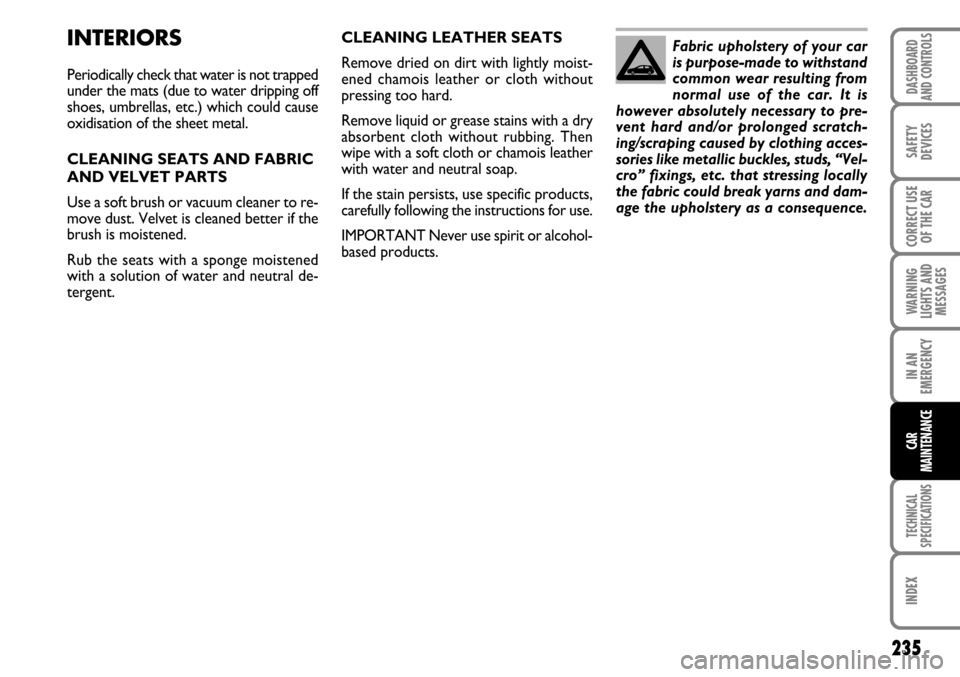
235
WARNING
LIGHTS AND
MESSAGES
TECHNICAL
SPECIFICATIONS
INDEX
DASHBOARD
AND CONTROLS
SAFETY
DEVICES
CORRECT USE
OF THE CAR
IN AN
EMERGENCY
CAR
MAINTENANCE
INTERIORS
Periodically check that water is not trapped
under the mats (due to water dripping off
shoes, umbrellas, etc.) which could cause
oxidisation of the sheet metal.
CLEANING SEATS AND FABRIC
AND VELVET PARTS
Use a soft brush or vacuum cleaner to re-
move dust. Velvet is cleaned better if the
brush is moistened.
Rub the seats with a sponge moistened
with a solution of water and neutral de-
tergent.CLEANING LEATHER SEATS
Remove dried on dirt with lightly moist-
ened chamois leather or cloth without
pressing too hard.
Remove liquid or grease stains with a dry
absorbent cloth without rubbing. Then
wipe with a soft cloth or chamois leather
with water and neutral soap.
If the stain persists, use specific products,
carefully following the instructions for use.
IMPORTANT Never use spirit or alcohol-
based products.Fabric upholstery of your car
is purpose-made to withstand
common wear resulting from
normal use of the car. It is
however absolutely necessary to pre-
vent hard and/or prolonged scratch-
ing/scraping caused by clothing acces-
sories like metallic buckles, studs, “Vel-
cro” fixings, etc. that stressing locally
the fabric could break yarns and dam-
age the upholstery as a consequence.
Page 237 of 274
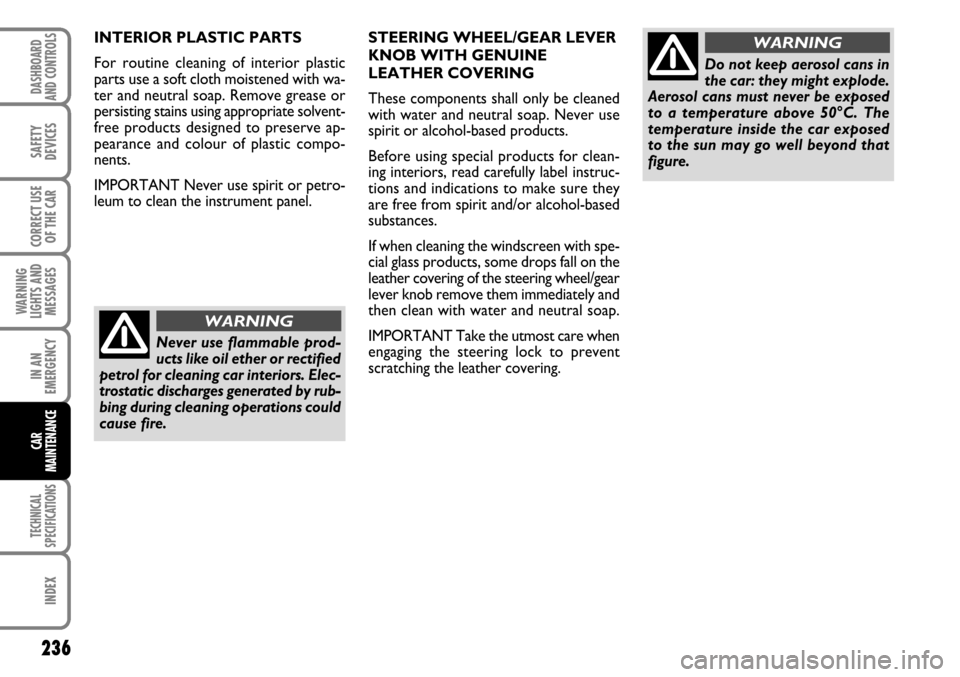
236
WARNING
LIGHTS AND
MESSAGES
TECHNICAL
SPECIFICATIONS
INDEX
DASHBOARD
AND CONTROLS
SAFETY
DEVICES
CORRECT USE
OF THE CAR
IN AN
EMERGENCY
CAR
MAINTENANCE
INTERIOR PLASTIC PARTS
For routine cleaning of interior plastic
parts use a soft cloth moistened with wa-
ter and neutral soap. Remove grease or
persisting stains using appropriate solvent-
free products designed to preserve ap-
pearance and colour of plastic compo-
nents.
IMPORTANT Never use spirit or petro-
leum to clean the instrument panel.STEERING WHEEL/GEAR LEVER
KNOB WITH GENUINE
LEATHER COVERING
These components shall only be cleaned
with water and neutral soap. Never use
spirit or alcohol-based products.
Before using special products for clean-
ing interiors, read carefully label instruc-
tions and indications to make sure they
are free from spirit and/or alcohol-based
substances.
If when cleaning the windscreen with spe-
cial glass products, some drops fall on the
leather covering of the steering wheel/gear
lever knob remove them immediately and
then clean with water and neutral soap.
IMPORTANT Take the utmost care when
engaging the steering lock to prevent
scratching the leather covering.
Do not keep aerosol cans in
the car: they might explode.
Aerosol cans must never be exposed
to a temperature above 50°C. The
temperature inside the car exposed
to the sun may go well beyond that
figure.
WARNING
Never use flammable prod-
ucts like oil ether or rectified
petrol for cleaning car interiors. Elec-
trostatic discharges generated by rub-
bing during cleaning operations could
cause fire.
WARNING
Page 238 of 274
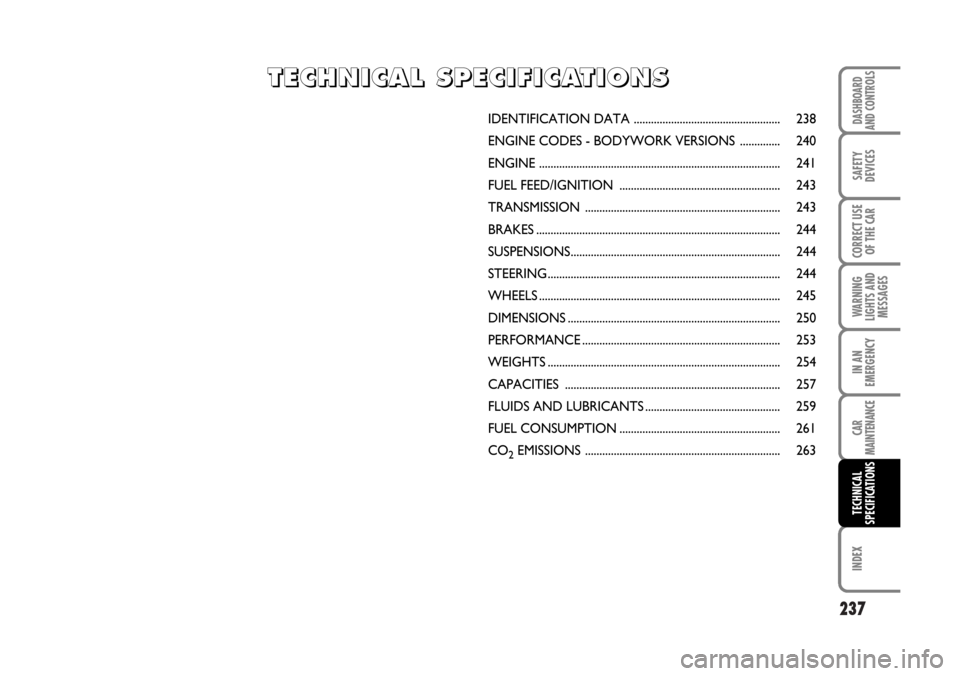
237
WARNING
LIGHTS AND
MESSAGES
INDEX
DASHBOARD
AND CONTROLS
SAFETY
DEVICES
CORRECT USE
OF THE CAR
IN AN
EMERGENCY
CAR
MAINTENANCE
TECHNICAL
SPECIFICATIONS
IDENTIFICATION DATA ................................................... 238
ENGINE CODES - BODYWORK VERSIONS .............. 240
ENGINE .................................................................................... 241
FUEL FEED/IGNITION ........................................................ 243
TRANSMISSION .................................................................... 243
BRAKES ..................................................................................... 244
SUSPENSIONS......................................................................... 244
STEERING ................................................................................. 244
WHEELS .................................................................................... 245
DIMENSIONS .......................................................................... 250
PERFORMANCE ..................................................................... 253
WEIGHTS ................................................................................. 254
CAPACITIES ........................................................................... 257
FLUIDS AND LUBRICANTS ............................................... 259
FUEL CONSUMPTION ........................................................ 261
CO
2EMISSIONS .................................................................... 263
T T
E E
C C
H H
N N
I I
C C
A A
L L
S S
P P
E E
C C
I I
F F
I I
C C
A A
T T
I I
O O
N N
S S
Page 239 of 274
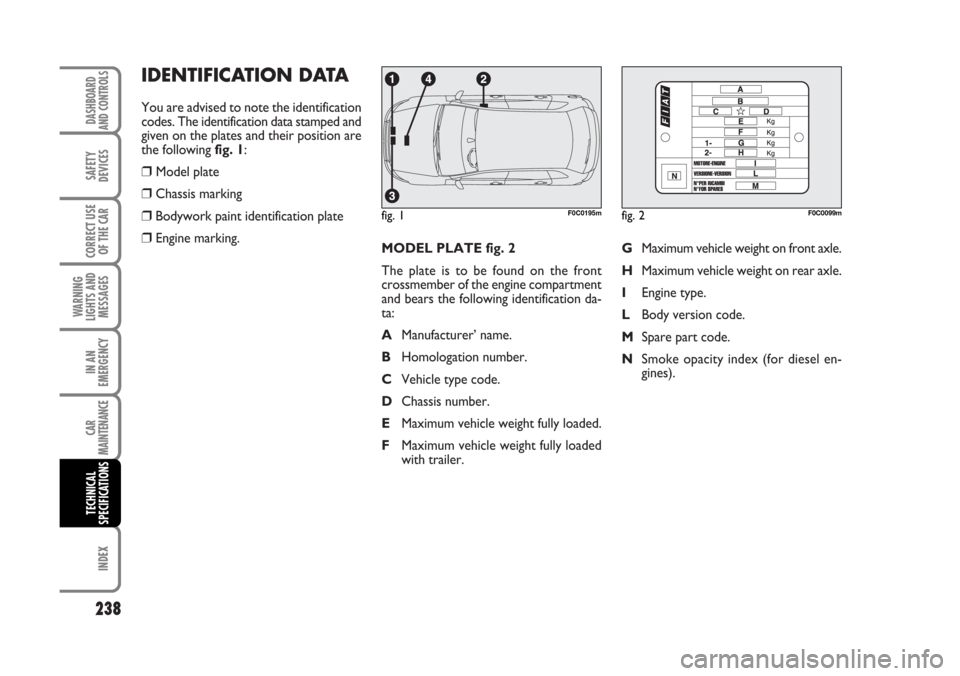
MODEL PLATE fig. 2
The plate is to be found on the front
crossmember of the engine compartment
and bears the following identification da-
ta:
AManufacturer’ name.
BHomologation number.
CVehicle type code.
DChassis number.
EMaximum vehicle weight fully loaded.
FMaximum vehicle weight fully loaded
with trailer.GMaximum vehicle weight on front axle.
HMaximum vehicle weight on rear axle.
IEngine type.
LBody version code.
MSpare part code.
NSmoke opacity index (for diesel en-
gines).
IDENTIFICATION DATA
You are advised to note the identification
codes. The identification data stamped and
given on the plates and their position are
the following fig. 1:
❒ Model plate
❒Chassis marking
❒Bodywork paint identification plate
❒Engine marking.
238
WARNING
LIGHTS AND
MESSAGES
INDEX
DASHBOARD
AND CONTROLS
SAFETY
DEVICES
CORRECT USE
OF THE CAR
IN AN
EMERGENCY
CAR
MAINTENANCE
TECHNICAL
SPECIFICATIONS
fig. 1F0C0195mfig. 2F0C0099m
Page 240 of 274
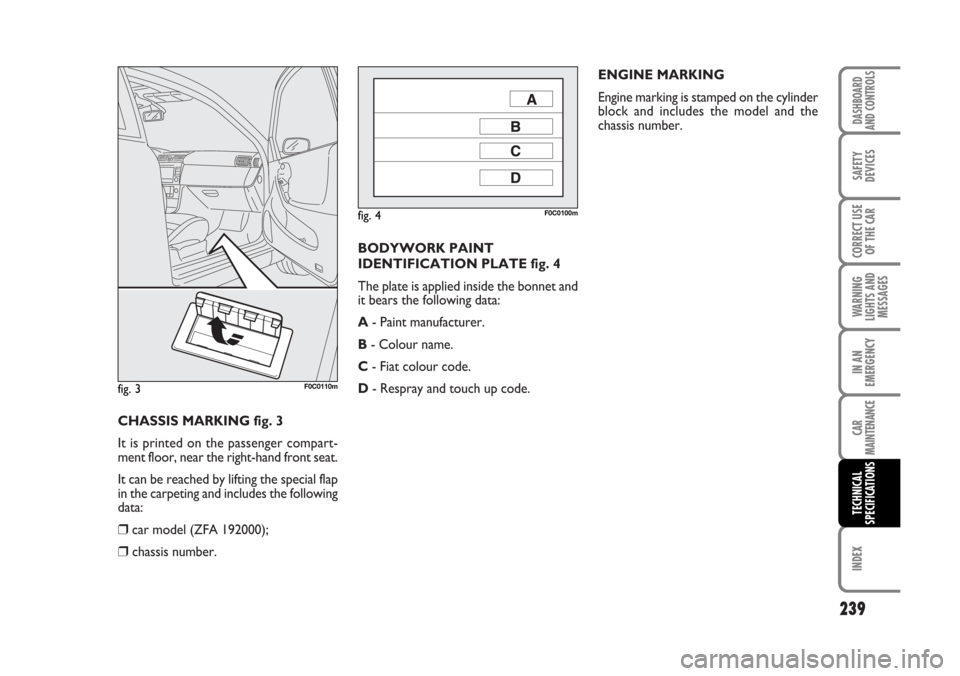
BODYWORK PAINT
IDENTIFICATION PLATE fig. 4
The plate is applied inside the bonnet and
it bears the following data:
A- Paint manufacturer.
B- Colour name.
C- Fiat colour code.
D- Respray and touch up code.ENGINE MARKING
Engine marking is stamped on the cylinder
block and includes the model and the
chassis number.
CHASSIS MARKING fig. 3
It is printed on the passenger compart-
ment floor, near the right-hand front seat.
It can be reached by lifting the special flap
in the carpeting and includes the following
data:
❒car model (ZFA 192000);
❒ chassis number.
239
WARNING
LIGHTS AND
MESSAGES
INDEX
DASHBOARD
AND CONTROLS
SAFETY
DEVICES
CORRECT USE
OF THE CAR
IN AN
EMERGENCY
CAR
MAINTENANCE
TECHNICAL
SPECIFICATIONS
fig. 4F0C0100m
fig. 3F0C0110m
Page 241 of 274
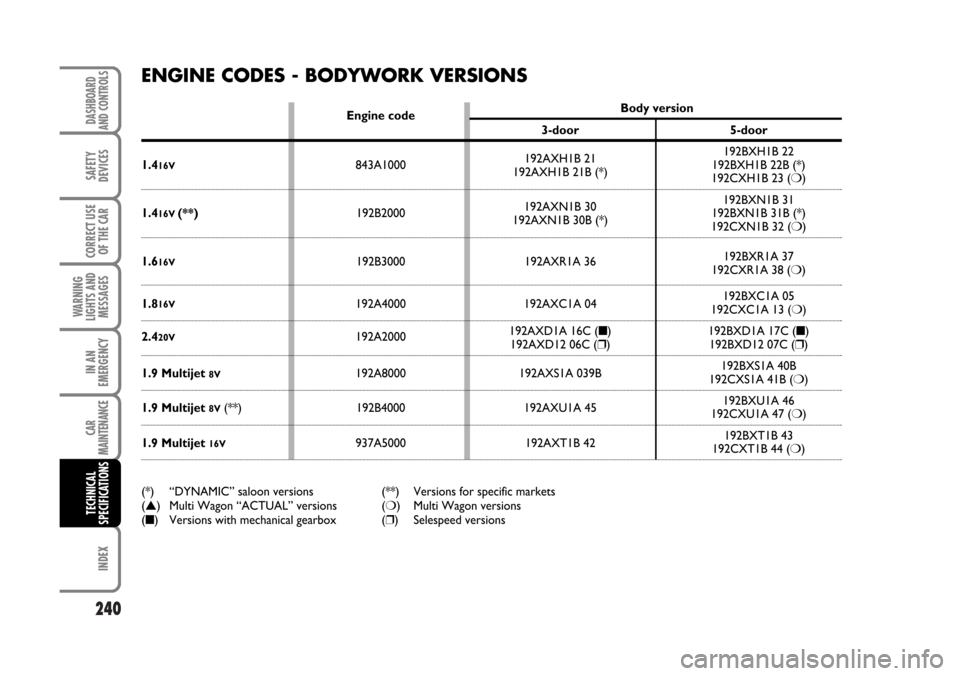
240
WARNING
LIGHTS AND
MESSAGES
INDEX
DASHBOARD
AND CONTROLS
SAFETY
DEVICES
CORRECT USE
OF THE CAR
IN AN
EMERGENCY
CAR
MAINTENANCE
TECHNICAL
SPECIFICATIONS
(*) “DYNAMIC” saloon versions (**) Versions for specific markets
(▲) Multi Wagon “ACTUAL” versions (❍) Multi Wagon versions
(■) Versions with mechanical gearbox (❒) Selespeed versions
ENGINE CODES - BODYWORK VERSIONS
Engine codeBody version
3-door 5-door
192AXH1B 21192BXH1B 22
1.4
16V843A1000
192AXH1B 21B (*)192BXH1B 22B (*)192CXH1B 23 (❍)
192AXN1B 30192BXN1B 31
1.4
16V (**)192B2000
192AXN1B 30B (*)192BXN1B 31B (*)192CXN1B 32 (❍)
192BXR1A 37
1.6
16V192B3000 192AXR1A 36
192CXR1A 38 (❍)
1.816V192A4000 192AXC1A 04192BXC1A 05192CXC1A 13 (❍)
2.4
20V192A2000192AXD1A 16C (■) 192BXD1A 17C (■)192AXD12 06C (❒) 192BXD12 07C (❒)
1.9 Multijet
8V192A8000 192AXS1A 039B192BXS1A 40B192CXS1A 41B (❍)
1.9 Multijet
8V(**) 192B4000 192AXU1A 45192BXU1A 46192CXU1A 47 (❍)
1.9 Multijet
16V937A5000 192AXT1B 42192BXT1B 43192CXT1B 44 (❍)
Page 242 of 274
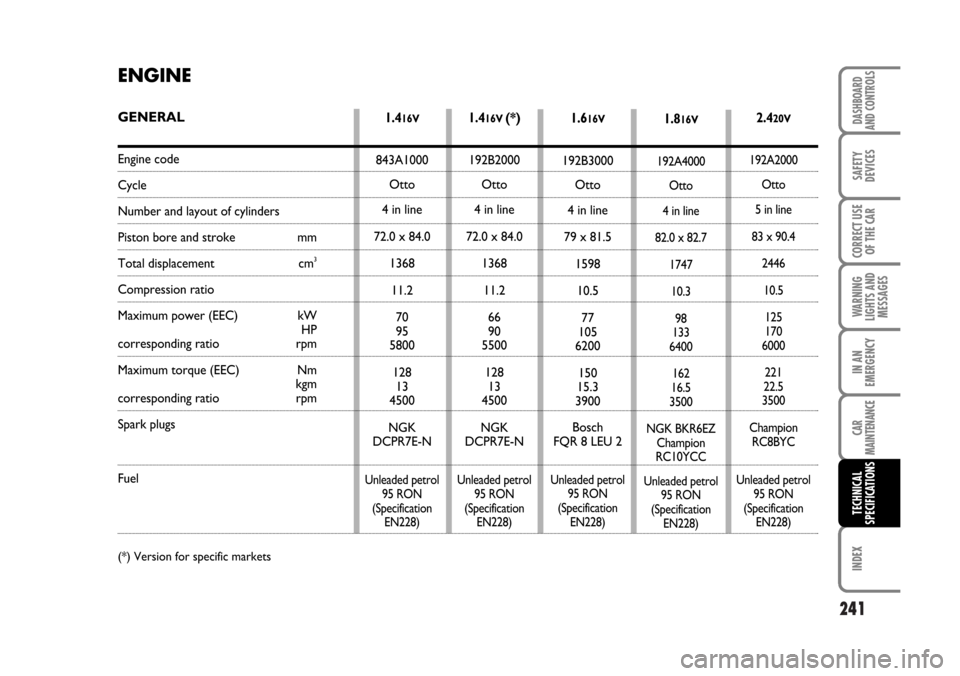
241
WARNING
LIGHTS AND
MESSAGES
INDEX
DASHBOARD
AND CONTROLS
SAFETY
DEVICES
CORRECT USE
OF THE CAR
IN AN
EMERGENCY
CAR
MAINTENANCE
TECHNICAL
SPECIFICATIONS
ENGINE
GENERAL
Engine code
Cycle
Number and layout of cylinders
Piston bore and stroke mm
Total displacement cm3
Compression ratio
Maximum power (EEC) kW
HP
corresponding ratio rpm
Maximum torque (EEC) Nm
kgm
corresponding ratio rpm
Spark plugs
Fuel
1.416V
843A1000
Otto
4 in line
72.0 x 84.0
1368
11.2
70
95
5800
128
13
4500
NGK
DCPR7E-N
Unleaded petrol
95 RON
(Specification
EN228)
1.416V (*)
192B2000
Otto
4 in line
72.0 x 84.0
1368
11.2
66
90
5500
128
13
4500
NGK
DCPR7E-N
Unleaded petrol
95 RON
(Specification
EN228)
1.616V
192B3000
Otto
4 in line
79 x 81.5
1598
10.5
77
105
6200
150
15.3
3900
Bosch
FQR 8 LEU 2
Unleaded petrol
95 RON
(Specification
EN228)
1.816V
192A4000
Otto
4 in line
82.0 x 82.7
1747
10.3
98
133
6400
162
16.5
3500
NGK BKR6EZ
Champion
RC10YCC
Unleaded petrol
95 RON
(Specification
EN228)
2.420V
192A2000
Otto
5 in line
83 x 90.4
2446
10.5
125
170
6000
221
22.5
3500
Champion
RC8BYC
Unleaded petrol
95 RON
(Specification
EN228)
(*) Version for specific markets
Page 243 of 274

242
WARNING
LIGHTS AND
MESSAGES
INDEX
DASHBOARD
AND CONTROLS
SAFETY
DEVICES
CORRECT USE
OF THE CAR
IN AN
EMERGENCY
CAR
MAINTENANCE
TECHNICAL
SPECIFICATIONS
(*) Version for specific markets
GENERAL
Engine code
Cycle
Number and layout of cylinders
Piston bore and stroke mm
Total displacement cm3
Compression ratio
Maximum power (EEC) kW
HP
corresponding ratio rpm
Maximum torque (EEC) Nm
kgm
corresponding ratio rpm
Fuel
1.9 Multijet 8V
192A8000
Diesel
4 in line
82.0 x 90.4
1910
18
88
120
4000
255
26
2000
Diesel fuel for
motor vehicles
(Specification EN590)
1.9 Multijet 16V
937A5000
Diesel
4 in line
82.0 x 90.4
1910
17.5
110
150
4000
305
31
2000
Diesel fuel for
motor vehicles
(Specification EN590)
1.9 Multijet 8V (*)
192B4000
Diesel
4 in line
82.0 x 90.4
1910
18
85
115
4000
255
26
2000
Diesel fuel for
motor vehicles
(Specification EN590)
1.9 Multijet 16V (*)
Diesel
4 in line
82.0 x 90.4
1910
17.5
100
136
4000
305
31
2000
Diesel fuel for
motor vehicles
(Specification EN590)
Page 244 of 274
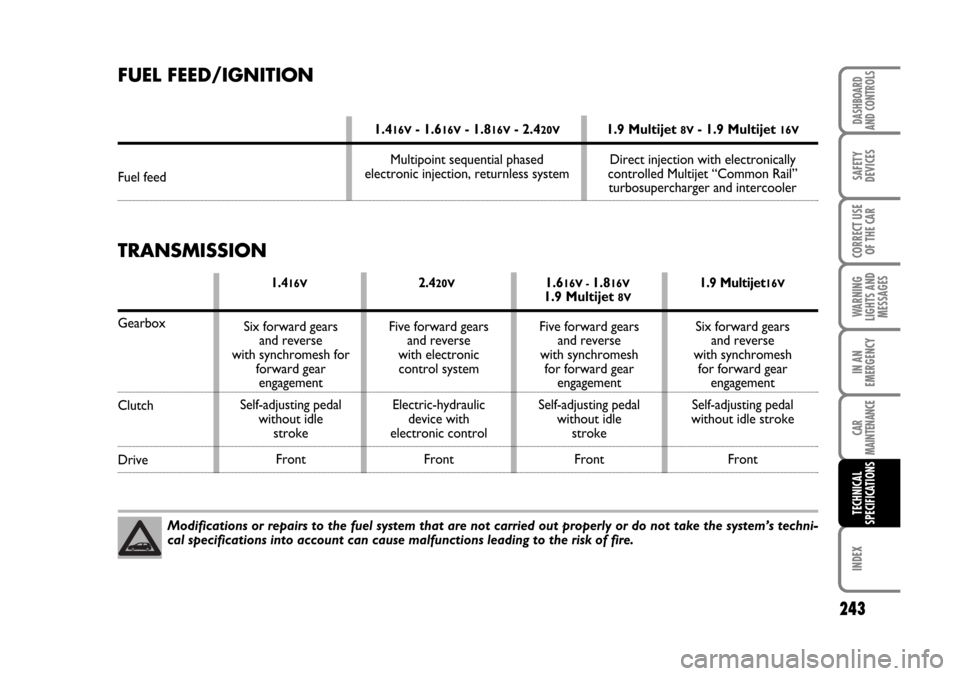
243
WARNING
LIGHTS AND
MESSAGES
INDEX
DASHBOARD
AND CONTROLS
SAFETY
DEVICES
CORRECT USE
OF THE CAR
IN AN
EMERGENCY
CAR
MAINTENANCE
TECHNICAL
SPECIFICATIONS
FUEL FEED/IGNITION
1.416V- 1.616V- 1.816V- 2.420V1.9 Multijet 8V- 1.9 Multijet 16V
Fuel feedMultipoint sequential phased Direct injection with electronically
electronic injection, returnless system controlled Multijet “Common Rail”turbosupercharger and intercooler
TRANSMISSION
1.416V2.420V1.616V - 1.816V1.9 Multijet16V1.9 Multijet 8V
Gearbox
Clutch
Drive
Modifications or repairs to the fuel system that are not carried out properly or do not take the system’s techni-
cal specifications into account can cause malfunctions leading to the risk of fire.
Six forward gears
and reverse
with synchromesh for
forward gear
engagement
Self-adjusting pedal
without idle
stroke
FrontFive forward gears
and reverse
with electronic
control system
Electric-hydraulic
device with
electronic control
FrontFive forward gears
and reverse
with synchromesh
for forward gear
engagement
Self-adjusting pedal
without idle
stroke
FrontSix forward gears
and reverse
with synchromesh
for forward gear
engagement
Self-adjusting pedal
without idle stroke
Front